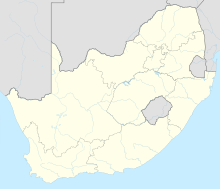| Location | |
|---|---|
| {{{subdivision_type}}} | Free State |
| Country | South Africa |
| Coordinates | 29°45′55″S 25°25′8″E / 29.76528°S 25.41889°E |
| Production | |
| Products | Diamonds |
| Greatest depth | 200 metres (660 ft) |
| History | |
| Opened | 1870 |
| Closed | 2002 |


Jagersfontein Mine /ˌjeɪɡərzˈfɒnteɪn/ was an open-pit mine in South Africa, located close to the town of Jagersfontein and about 110 kilometres (68 miles) south-west of Bloemfontein.[1][2] Since it was first established,[3][4] two of the ten biggest diamonds ever discovered, the Excelsior and the Reitz (now called the Jubilee), were mined from Jagersfontein.[2] The term "Jagers" has since been coined to denote the distinctive faint bluish tint of the gems from this mine.[5] Among geologists, Jagersfontein is known as a kimberlite pipe,[6] and a prime locality for mantle xenoliths, some of which are believed to have come from depths of 300–500 km (190–310 mi).[1]
It is the biggest hand-excavated hole in the world at 19.65 hectares (48.6 acres), slightly larger than the Big Hole of 17 ha (42 acres) in Kimberley, which had previously claimed the title.[7]
- ^ a b "Jagersfontein Mine, Jagersfontein, Free State Province, South Africa", Mindat.org
- ^ a b Jagersfontein Archived 2019-12-17 at the Wayback Machine, Places.co.za
- ^ Jagersfontein entry, Encyclopædia Britannica
- ^ "Jagersfontein Mine", Showcaves.com
- ^ "The Excelsior Diamond", Famous, Historic and Notable Diamonds, Tripod.com
- ^ Photograph showing the circular geometry of the Jagersfontein kimberlite, Department of Terrestrial Magnetism, Carnegie Institution of Washington
Stressed Pyroxenite Nodules from the Jagersfontein Kimberlite Archived 2018-07-01 at the Wayback Machine, G. D. Borley and P. Suddaby, Mineralogical Magazine; March 1975 v. 40; no. 309; p. 6-12; doi:10.1180/minmag.1975.040.309.02
Iron carbide and metallic inclusions in diamonds from Jagersfontein, A. P. Jones, D. Dobson, I. Wood, A. D. Beard, A. Verchovsky, H. J. Milledge, 9th International Kimberlite Conference Extended Abstract No. 9IKC-A-00360, 2008 - ^ Cite error: The named reference
holewas invoked but never defined (see the help page).
